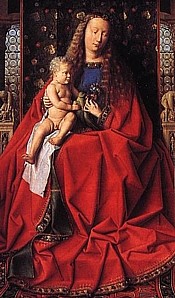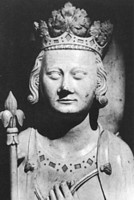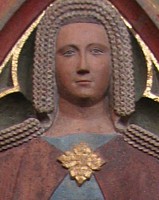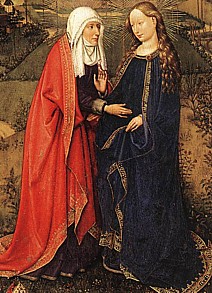|

Medieval
Cloaks & Mantles
STYLES - FABRICS & LININGS - FASTENINGS - DECORATION
Styles
 In
the 12th century, English cloaks with hoods attached were exported
across the Roman kingdom. Known as British cloaks, they
were thick wool and particularly weatherproof and waterproof. In
the 12th century, English cloaks with hoods attached were exported
across the Roman kingdom. Known as British cloaks, they
were thick wool and particularly weatherproof and waterproof.
In the middle of the medieval period, the cloak most commonly
worn by women was the mantle. It was worn as the outermost
layer of clothing in the middle ages. Indeed from antiquity and
onwards through to the 19th century, cloaks for both sexes remained
a popular garment for traveling and for wear out of doors, particularly
in cold climates.
Mantles and
cloaks at that time appear to be unhooded; the hood usually worn
as a separate item of clothing and having a cowl.
Many illustrations and illuminations from the Middle Ages show
a cloak which drapes over the head and does not fasten at all.
It would appear that this garment may not be shaped and not be
a garment as such. It appears in many cases to be just a large,
wrapped piece of heavy fabric which has a highly decorative border.
Cloaks for traveling in the medieval period tended to be thick
and warm, often fur lined for those who could afford such luxury.
Wool, with it's weather resistant properties made it a natural
choice for outdoor wear.
One account for working class people states that the garment is
first a cloak and then cut down into a mantle when it is
worn, hinting that a cloak may be hooded for outdoor travel, and
then rehemmed with the hood cut off later, when the separate hood
with its own cowl would have been worn.
Pierce the Ploughman's Crede
writes of a wife working in the field with her husband-
In a clouted coat cut
short to the knee,
wrapped in a winnowing sheet to keep out the weather..
Mantles of a lighter nature
also appear to have been worn. The drape of the fabric and colours
in many paintings suggest many of these were unlined.
Our model woman from the 14th century, Margherita Datini owned
six cloaks/mantles at the time of her household account in 1397.
It is not unreasonable to assume that they were not identical,
but were of differing thickness and suited to different weather
conditions. It is possible she had duplicate quality in differing
colours for the sake of fashion, but it is probable that hers
were suited to different seasons and purposes.

Fabrics
and linings
Mantles were made of various materials but it not not unreasonable
to assume that functional, cold-weather ones were wool, owing
to the nature of the fabric.
Wool lined with fur would give the heavy drape depicted in representations
of mantles and cloaks in contemporary artworks and sculptures.
Wool is warm and naturally weatherproof, especially when felted,
and was produced in a variety of qualities and finishes making
it suitable for an outer garment.
Most illustrations appear to show the mantle to be lined with
fur or some kind.  Once
again, this would reflect the status of the wearer and Sumptuary
Laws of the region and year. Once
again, this would reflect the status of the wearer and Sumptuary
Laws of the region and year.

Cloak
fastenings
Mantles for many women seem to be fastened across the front, with
a cord and two brooches of some kind on each side at clavicle
height. Many contemporary illustrations show this style with the
mantle apart, although one imagines that the cord could be drawn
or tied together on colder days for warmth.
Shown at right is the head
of the effigy of Philip IV from 1327 showing the mantle fastening
with a tasseled cord. The cord would be tied at the front pulling
the two sides closer together.
 The
other method of fastening for the mantle or cloak is a large jewelled
brooch or pair of brooches. The
other method of fastening for the mantle or cloak is a large jewelled
brooch or pair of brooches.
These were often highly ornate and costly but were not a part
of the cloak per se, that is, they were not stitched on and were
removable.
Whether there was a reinforced eyelet for the brooch to fasten
through or whether it was fastened directly through the fabric
is not known, although it appears that no special holes were made
for this purpose.
The 1370 German tomb effigy at left shows a very large gold brooch
fastening a lightweight mantle on the wife of a man in Bartholemeus
Cathedral.

Decoration
 As
with most other forms of medieval clothing, mantles could also
be decorated, although it was not unusual for cloaks to be plain. As
with most other forms of medieval clothing, mantles could also
be decorated, although it was not unusual for cloaks to be plain.
In art we see the Virgin Mary, often with large, elaborate gold
embroidery, mottoes or jewelled bands on her mantle. The two details
from the paintings on this page show samples of both.
At the right, the 1434-1435
painting by Daret, Visitation shows elaborate embroidery
on both women's mantles and one with shaping, gathered fabric
on a neckband, a front fastening of cord and two jeweled brooches
and the other with no real shape or fastening..
At the top of the page, the 1436 Jan van Eyck The Madonna with
Canon van der Paele shows a band around the hem and up the
front set with gemstones and thin gold cord fastening.

Copyright
© Rosalie Gilbert
All text & photographs within this site are the property of
Rosalie Gilbert unless stated.
Art & artifact images remain the property of the owner.
Images and text may not be copied and used without permission.
|